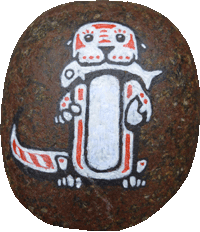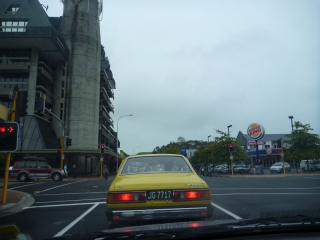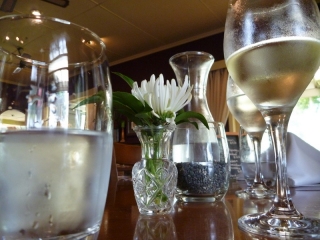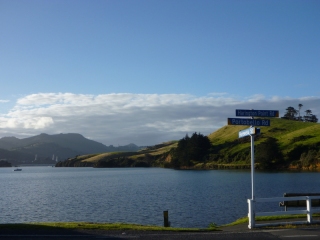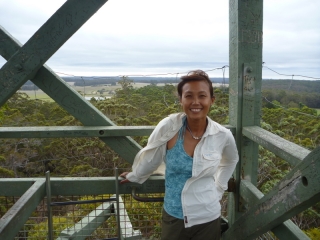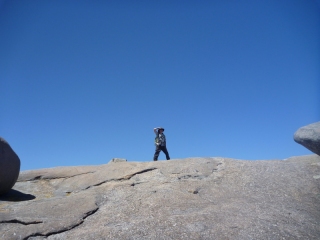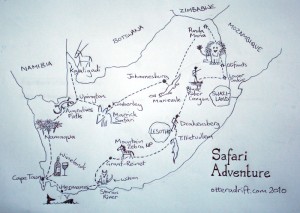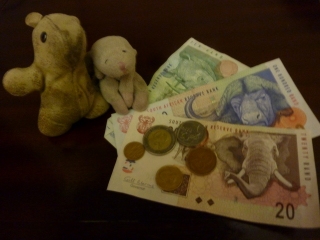Switching to PolarSteps…
So I’ve decided to switch our travel blog to PolarSteps (www.polarsteps.com). It’s still Otter Adrift, so the link to our blog will actually be: https://www.polarsteps.com/otteradrift
None of this blog will disappear – I’m actually going to add one little “trip” to Polarsteps for each of past trips and just make it a link back to the right part of this older blog, so nothing is lost. But any new trips will be on Polarsteps.
Why?
Well… firstly because I love maps, and so mapping all our trips neatly is one of the lovely attractions of Polarsteps. Also, the photo-uploading on this old home-hosted WordPress blog has always been a PITA and, if I’m honest, a good reason for a procrastinator like me to put off actually adding new trips. Polarsteps is a lovely modern app, photo uploading is ridiculous easy.
The trial run was our 6 week trip around Patagonia. So let’s compare that with the last trip written up on this blog, our 4 week trip around northern Italy…
- By the end of our trip around Patagonia, all the photos were on Polarsteps and all but the last 4 or 5 blogs were written. There was a bit of editing and summarising to do, but that’s all.
- By the end of our trip around Italy, only about a third of the blogs were written, others had scribbled notes, and no photos had been uploaded. It was all left to do once we got home.
So that’s pretty much conclusive. Polarsteps (although it has some frustrations) is going to be a much better place for me to blog our travels.
Related Images:
The final route
Gosh, we didn’t change very much. Apart from fiddling around with our arrival in New Zealand so that we were visiting in autumn rather than winter (well worth it) we didn’t change a single leg of our Round-the-World ticket.
We did add two additional countries to our original list, though. Having arrived in Chile and realising it was too cold to enjoy Patagonia properly, we looked to the north and wondered whether it was worth seeing some of the key sites of Peru while we were on the other side of the world. Having decided that we should, it seemed a very tight fit. So rather than try and do it entirely independently we looked for a tour at a keen price, and found Peru Travel Plan (effectively part of Rickshaw Travel). They sort out transport, accommodation and a couple of key tours – but they don’t put you up in bland yet expensive 4-star hotels and they don’t ferry you around the whole route in a deluxe coach; they book the kind of hotels we might pick ourselves, and they use the same public buses that independent travellers and better-off locals use.
So we flew from Santiago to La Paz, adding Bolivia to our trip – albeit only three days. From La Paz via Lake Titicaca to Cusco, gateway to Machu Picchu. Then Cusco to Arequipa for the Colca Canyon. How exactly these arrangements turned out you’ll need to read back through the blog to discover.
Our Peru whistle-stop aside, why didn’t our itinerary change much from our original plans? Most travellers seem to. I think partly it’s because we were touring the whole way around the world – we never stopped to volunteer or work anywhere, we never stopped to stay with friends. And we had a keen sense that we wanted to see all the places we had on our itinerary, so even when we found spots like Tillietudlem or Meditasi or Chepu where we could have cheerfully chilled out for another week it was the thought of what else we’d have to miss out on that kept us on track.
Related Images:
Travelling light
I think we can definitely recommend travelling light. Passing through airports or wandering around tourist towns with a backpack on my shoulders and a satchel at my side I felt much freer than either the ones lugging enormous suitcases on wheels or those hefting super-sized backpacks on their back and another almost as big on their front. And we’re definitely taking the experience of this year into our shorter holidays and breaks in future – two modest backpacks are infinitely better on every occasion than the wheelie suitcases or hold-alls that we’ve used in the past.
For us these Osprey backpacks were perfect. The airflow system at the back means never getting sweaty, and the 55L his and 45L hers gave us just the right amount of space, along with my satchel and one other carry-on bag. The second carry-on began as a canvas beach bag, but ended up as a small backpack when we found that emptying Maureen’s 45L to use as a day-bag was just too much hassle for every little day hike or day trip we took.
Our security wallet, meant to hang around the neck and live under my shirt, never got used. Cash for that day’s use went into my pockets, the rest split between satchel and the luggage back at our hotel room. If we took our passports out they also lived in the most secure pocket of my many-pocketted satchel. The security wallet is especially stupid in tropical countries where you wear T-shirts and the wallet sits obviously underneath the T-shirt screaming ‘hello, I’m a security wallet!’
I’d like to add a word about my satchel, because I think it’s pretty perfect too. Aesthetically it looked equally at home in the wild or in the city. Also, hung across the body it would be almost impossible for someone to snatch off and it sits on my hip which means I’m more aware of it than I would be of something on my back. And when we were somewhere that seemed a little less secure, it’s just as easy to have it in front of the hip.
One bit of advice about ‘travelling light’ that is often mentioned is buying readily available things (like shampoo or suntan lotion) when you arrive at your exotic destination. That’s tricky, as once you’ve got your shampoo you still need to have space to pack it. So it could be worth looking for small or compact versions at home before you get going, as there may be less choice overseas. Shaving oil is my favourite example. The Body Shop do a little 15ml bottle of shaving oil, very good stuff for a wet shave and it lasted four months. I’ve searched long and hard for shaving cream, foam, gel or oil elsewhere and I’ve never seen it in a compact form suitable for travelling.
Finally, check out the final packing list. The crossed-out items include a bunch of things we wouldn’t take next time (there’s definitely going to be a next time!), so I reckon that we can aim to travel even lighter than we have been.
Related Images:
South America budget update
Written by Maureen
Chile
Accommodation cost on average £39, mostly in hostels which were adequate if chilly. We liked best our cabin in Chepu, Chiloe, and our room in Terrace Lodge, Putre. The best food we had in Chile was in Valparaiso where we self-catered (£11 per day). Otherwise, we spent on average £25 per day for uninspiring and occasionally dire food, even though we often skipped lunch or dinner.
Inter-city buses were good value and comfortable; it costs around £16pp for the 9-hour journey from Arica to Calama, or £7 return for the 1.5hr journey from Santiago to Valparaiso. But bear in mind that Chile stretches thousands of miles from north to south. It would take several days of travel by bus to go from Arica on the Peru border to Puerto Montt in the south, hence the three extra flights we took – £278 per person with LAN. We hired a car twice to explore individual areas at £52 a day including petrol. The one from Arica was very old and lacked aircon but somehow it survived the Atacama dust better than we did. Drivers in Chile were considerate and roads were generally good except for one nightmare mud-wallow in Chiloe.
Apart from boat trips to look for otters in Chepu, and two excursions around San Pedro de Atacama, we spent very little on extras. A fancy dinner in Santiago and a 4-hour horse-riding trip in the Atacama desert went under special-fun.
We spent on average £107 per day, excluding the internal flights. Verdict: overspent by £500.
La Paz and Peru
We spent approx £15 per day on food in La Paz, and £33 per day in Peru. We took a few additional excursions although none of these were particularly expensive.
Inevitably (we were in South America after all), we suffered some transport problems which incurred additional costs due to our tight schedule. What really stung, however, was the £400 we had to spend on a last-minute flight from La Paz to Cusco – it’s only 30 minutes long, so that’s £6.33 per person per minute in the air! Probably the most expensive economy seat in history. Although we never got a refund, the local tour agencies who handled our programme were responsive and helped us to deal with problems promptly. Nevertheless…
Excluding the unexpected costs, we spent approx £134 per day which over two weeks amounted to £580 in the red. I’m sure you can spend much less travelling independently and perhaps this is what we should have done.
Ecuador
Four days full-board in Sacha lodge in the Amazon costs £140pppn. Flights to Coca, the springboard to the jungle, were an additional £72pp.
Our Galapagos “comfort” cruise included four nights on the boat, two nights in a soulless hotel in Quito and return flights to the Galapagos. The total package costs just under £1,500pp.
We spent four additional nights in Quito, and got some good hotel deals – for £73 per night, we stayed in a 2-bed apartment in modern Quito, and a superior room in a beautiful colonial hotel in old Quito. Ok, I admit I’m a bit fed up with hostels by now. By contrast, in Mindo, for £24 per night we stayed in a comfy cabin set in a lovely garden full of wildlife! We splashed out on our last two nights of the trip and stayed in a resort with its own thermal baths.
We had a couple of nice meals in Ecuador and stuck mainly to tourist restaurants; on average food came to approx £40pd.
We hired a car for four days at £24 a day including petrol. Driving in Ecuador was quite nerve-racking – overtaking on a blind corner in thick fog is normal behaviour. Also, don’t expect signposts and you won’t be disappointed.
We hired a bird-watching guide twice and went horse-riding in a volcanic crater.
£3000 of this went into the special fun budget. So of the rest our average spend was £128, which was £504 over-budget.
Overall
At the end of our trip our £100 per day budget ended up £4500 overdrawn, almost 75% of this down to Australia. But still, that means we actually spent an equivalent of £112 per day which doesn’t look too bad. Our special-fun budget (thanks mum and dad!) ended up overdrawn by £680, which is less than £2 per day. The things not included in these figures are (a) our RTW tickets and everything we spent before actually setting out, (b) a few cool items of clothing that we bought and sent straight home, (c) some of our internal flights in Australia – yep, it actually cost even more touring there.
Related Images:
Clothes for everywhere
So how about a few thoughts on our packing choices for clothes and footwear, and how they turned out?
- Jeans are simply essential. I know they are bulky and take ages to dry, but my answers are as follows: (a) wear them on plane and bus journeys, then you don’t need to pack them, (b) don’t wear them on hikes, boat trips and jungle adventures and they won’t need washing, (c) you can walk into any restaurant, shop, hotel, bar or venue in the entire world in jeans and you won’t feel out of place
- The walking shoes we took were perfect. As expected, their breathability was far more important for all the months tramping around hot tropical places than the very occasional day walking through mud or in torrential rain. In any case, when we did get totally soaked then at least these dried quickly. And their muted colours and shoe-like appearance meant we felt comfortable in nice restaurants.
- Technical garments feel good on hikes, but don’t overdo it or you’ll start to be fed up with looking dull in vibrant cities and funky restaurants. Their best attribute is actually how quickly they dry, and the most important technical things to have are hiking trousers and a warm top (fleece or merino) because they’re so light, compact and quick-drying compared to a basic sweater or jumper
- Flip-flops are vital footwear, for flopping around hotels or for anywhere wet – the simple difference with sandals is that sandals you have to put on, flip-flops you just walk into. But make sure you get all-rubber ones; any fabric takes ages to dry out
- The tube scarf is really versatile as neck wear or to tie up long hair, and very light. In contrast the cobber is a pain in the arse for a traveller – firstly you have to remember to soak it before you head out on a hot hike, and then it’s a pain to pack again because it stays wet for 4+ days so it either gets other things wet or if you put it in a plastic bag it goes mouldy!
- I like my linen blazer. Maybe I’m turning into Alan Whicker, but once I throw it over jeans and a T-shirt I feel like I can walk into any restaurant, shop, winery or hotel and belong
- My wallet should have stayed at home. It’s visible in any pocket, and puts all your eggs in one basket. I kept coins and some small notes in one pocket, credit cards and a few more notes in my other pocket, and the rest of our money hidden in a couple of places in day bags and the main backpacks. Hmm… girls who don’t have/use pockets may have to stick with a purse
Related Images:
The final pack
So this is what we shoved back into our rucksacks on the final morning as we prepared for our flight back to England. Well, in fact it’s a copy of the original list with amendments. Items we picked up are in italics, while things we got rid of or would not take again are struck through. Hope future travellers find it useful, although please note that we did no camping and so our conclusions won’t quite suit a couple planning on spending time under canvas!
| Electronics | |
| Netbook (Toshiba NB200) | Lovely compact netbook, survived beautifully |
| Netbook case (Zeroshock III in white) | Compact yet protected brilliantly |
| DSLR camera (Nikon D50) | Survived knocks, but probably due for an newer model |
| Too similar to compact to be worth taking again | |
| 70-300mm VR Nikkor telephoto zoom lens | Vital for wildlife, especially the Vibration Reduction |
| Sent home – too often screwed up the autofocus, and got better results just using the 300mm lens then cropping the image on the laptop | |
| Never used on the 70-300, on the 18-55 made shots better than the super-compact – but a luxury I’d leave behind next time | |
| Charger and spare battery for DSLR | Used the spare several times |
| Air blower for DSLR | Used to puff dust off the sensor |
| Lens motor broke, probably due to cold, dust and rain | |
| Sent home – new camera tough and lives in pocket or backpack | |
| Sent home – no longer needed when ZX-1 broke | |
| Super-compact camera (Panasonic Lumix FT-2) | Waterproof, dustproof, knockproof – much better companion for the DSLR |
| Floating wrist-strap for camera | Freebie, but seems sensible for snorkelling |
| 2GB SD cards x 3 (for cameras) | Only ever needed two, as downloaded every day |
| 16GB SDHC cards x 2 (for backups) | Ended up needing four |
| USB adapter for SD card | Very useful for putting stuff on other computers (e.g. for printing) |
| Binoculars (Opticron x10) | Vital for wildlife |
| Mobile phone x 2 (iPhone 3G) | Only ever used one, and would have preferred just one basic little mobile |
| Bad connections, time lags, pain in the neck | |
| iPod x 2 | Both used for long bus/plane/train and car |
| Mini speaker | With iPod in hire cars – perfect |
| International plug adaptor | Vital |
| Amazon Kindle | Used in place of reading books right through, cracked by a couple of drops but still working fine |
| Packs and packing | |
| Rucksacks x 2 (Osprey Atmos 45 and 55 litres) | Perfect size for our purposes |
| Rucksack raincover x 2 | Used a couple of times, but would be bad not to have them |
| Cable lock (PacSafe) | Only used once, but we were lucky with accommodation and transport |
| Combination padlock x 2 | Felt better leaving the rucksack locked |
| Satchel (Howies, canvas) | Great around town – at my side/front, not on my back |
| Packing cubes (Eagle Creek, 2 cubes, 3 half-cubes) | Vital. Might take one less half-cube next time |
| Waterproof dry bag | Vital several times for keeping camera etc. dry in canoes |
| Ziplock bags | Always had one or two for liquids at airports |
| Airtight plastic food box | Used a handful of times (e.g. keeping spare portions of food) |
| Never used | |
| Mini pill case | To keep a few useful pills (e.g. neurofen and immodium) in a day bag |
| Small rucksack | Very useful day bag for hikes etc. when the satchel is too small |
| Bum bag | Useful for short hikes or for organising little bits in bigger bags |
| Clothing – Maureen | |
| The changes here mainly reflect how easily Maureen feels the cold | |
| Lightweight waterproof jacket | Useful against cold as well as rain |
| Sleeveless down jacket | Very useful in colder climate |
| Long-sleeved down jacket | Would never survive the Andes without it |
| Smart town jacket | To be smart and warm in cities |
| Lightweight fleece pullover | Vital warm top |
| Jeans | Vital for comfort in cities and evening meals |
| Lightweight hiking trousers x 2 | Could have stuck with one |
| Warm hiking trousers | Picked up for Andes, and useful |
| Merino leggings (Icebreaker) | For cold nights and cold days |
| Long-sleeve merino top | Useful warm layer |
| Long-sleeve trek shirt | Useful layer against sun or cold |
| Technical T-shirt x 2 | Vital on hikes/wildlife trips |
| T-shirt | Prettier than the technical ones |
| Vest top x 1 | Ended up with 2, both prettier than the original technical one |
| Pretty long-sleeved top | To look good for evening meals |
| Shorts | For bumming around hotels |
| Swimsuit | Got plenty of use |
| Silk nightwear (shirt + shorts) | Used every night |
| Hiking socks x 4 | Started and ended with 4 |
| Bra x 3 (2 sports, 1 lightweight) | About right |
| Underwear x 5 | Ended up with 7, but 5 worked |
| Silk gloves | Not warm enough on their own in the real cold |
| Gloves | Vital for cold places |
| Lightweight tube scarf | Really useful in the cold and hot |
| Walking shoes (Montrail, not waterproof) | Perfect, and breathability much more useful than waterproof |
| Sandals (Teva) | Used a fair bit, but could live without |
| Pretty flip-flops | Only used a handful of times |
| Rubber flip-flops | Used loads around hotels and on beaches |
| Sarong | Much more useful than a towel |
| DVT socks (for the plane) | Vital |
| Baseball cap | Vital headgear |
| Clothing – Matthew | |
| Lightweight waterproof jacket (Marmot) | Used for cold as well as rain |
| Sleeveless down jacket | Vital in cold places |
| Zip-up merino top (Icebreaker) | Vital warm top |
| Linen blazer | Looks smart in cities and evenings – might not be for everyone! |
| Jeans | Vital for comfort in cities and evening meals |
| Lightweight hiking trousers | Used for adventures everywhere |
| Used in freezing Nepal trek lodges, but sent home after unneeded | |
| Long-sleeved trek shirt | Good layer for hikes/wildlife trips etc. |
| Long-sleeved shirt | Good for towns and evening meals |
| Long-sleeved merino top | Good layer for the cold |
| Short-sleeved shirt | Ended up with two |
| Technical T-shirt x 2 | Very good for hikes/wildlife |
| T-shirt x 2 | Various swaps but ended with 3 and a bit more trendy than the original 2 |
| Swimming shorts | Used for swimming and wearing as shorts |
| Hiking socks x 4 | Seemed the right amount |
| Underwear x 4 | Ended with 5 but 4 would do |
| Too obvious a target | |
| Belt (canvas webbing) | Also useful at times for securing things |
| Silk gloves | Useful against chilly nights |
| Cotton scarf | Useful on cold nights, but could do without |
| Walking shoes (Montrail, not waterproof) | Perfect for everything |
| Flip-flops | Replaced originals with an all-rubber pair, perfect for wet conditions and around hotels |
| Too inconvenient to use | |
| Replaced with The Indy | |
| Wide-brimmed hat (the Indy) | Shades all the face and the neck – much better |
| Medicine and toiletries | |
| Sterile first-aid kit | Never used, but vital insurance I think |
| Blister plasters | Used a couple of them |
| Washbag x 2 | Proved ideal |
| Small scissors | Used several times |
| Nail clippers | Used regularly |
| Tweezers | Used regularly |
| Sent home – couldn’t get the hang of it, and didn’t need much either | |
| Hand sanitizer (small bottle) | Very useful after touching icky stuff or before street snacking |
| Lipbalm with sunscreen | Vital |
| Sunscreen | Vital, mostly the 30 rated for exposed skin when snorkelling |
| Vaccination record books | Never needed (luckily) |
| Insect repellant (DEET) | Used a lot, found roll-on stick best |
| Plug-in mosquito killer + 30 tablets | Used most but not all tablets |
| Too short-lived for a long trip | |
| Never tried, and pills worked fine | |
| Motion sickness pills | Vital for Matthew in Galapagos and a couple of other boat trips |
| Wet wipes (small pack) | Useful after long bus/plane/train journeys |
| Stretchy support bandage | Not used, but good insurance against ankle twists |
| Equipment | |
| Leatherman multitool | Used several times, esp knife and scissors |
| Universal sink plug | Used several times for baths and clothes washing |
| Elastic twisty clothesline | Vital for drying washed clothes |
| Compass | Never used, but would still take for long hikes |
| Small scrub-brush | Useful various times |
| Laundry soap block | For clothes washing, used a lot |
| Spare shoelaces | Good insurance, and used occasionally to tie stuff |
| Only used for rented sleeping bags in Nepal | |
| Umbrella (ultra-compact) | Used a few times in town and city |
| Sewing kit (hotel freebie kind) | Used several times |
| Duct tape (small roll) | Used several times |
| Water filter bottle (TravelTap 600ml) | Really useful and saved loads of plastic |
| Metal water bottle (1000ml) | Better than reusing plastic bottles |
| Water bottle shoulder sling | Very useful when not taking a rucksack around |
| Head torch x 2 (Petzl) | Worked very well |
| Strong handheld torch (Ultrafire) | Specifically for wildlife-spotting at night, very compact |
| Used exactly twice, not necessary | |
| Sarongs are much more useful and all hotels have towels | |
| Flannel | Useful little addition for washing or for drying |
| Sunglasses x 2 | Vital |
| Spare glasses x 2 | Vital |
| Earplugs | Only used once, but tiny anyway |
| Paperwork | |
| Passports | Vital |
| UK driving license | Needed in some countries |
| International driving license | Needed in some countries |
| Travel insurance details | Vital |
| Credit cards x 3 | Vital (two might be okay, one is too chancy) |
| Tickets | Duh |
| Photocopies of the above | Useful insurance |
| Guidebook (to current and/or next country) | Vital |
| Travel journal | Notebook in effect, vital for noting hotel details, directions, plans, lists, etc. |
| Pencils x 4 | Plenty of use, and a biro too for airport forms |
Related Images:
Australasia Budget Update
“A descent into budget anarchy” or “How not to budget”
Written by Maureen, ex-Financial Director of M&M
Disclaimer: This budget post-mortem contains explicit despair.
So… what went wrong?
A: Australia is expensive.
B: The exchange rate is lousy.
C: It’s a whole continent and we only had a few weeks
D: A complete failure in self control
E: All of the above
We ended our tour of Asia congratulating ourselves for being £1,000 below budget. We left Australia and New Zealand shell-shocked and
We spent ten days in and around Sydney, at the beginning and the end of our trip. We averaged a modest £113 per day, including a 4-day car hire.
For our first week in Western Australia, we were spoilt rotten by Matt’s parents and spent very little. But we soon found that trying to stay in budget in Australia was not easy. Still, we were very determined and bargained hard, always looking for the cheapest options and checking the price of every supermarket purchase. I remember passing up a lovely cottage and opting for a cold hostel to save £10. Luckily, we didn’t have to pay for the car hire (thanks again, Carol and Geoff) though the 4×4 guzzled petrol like an alcoholic on wheels. By careful management, we did stay (just about) under budget, spending on average £98 per day, but it was a hard and cheerless time.
Surely New Zealand would be easier! We spent just under a month on South Island and, again, were pampered by Matt’s parents for the first week. Our car was a good deal even if we weren’t too keen on the bold paintwork advertising, but alas it never made it to the end of the trip. It gave up the ghost with only four days to go and we had to rent a replacement from a different company for 240% the price of the first (thanks, Jucy, for leaving us in a lurch). Accommodation was on average £52 per night and mostly lovely, including motels, a tourist park, hostels, our own three-bed period house, a tranquil waterside lodge, and a night on a floating boat. In the end, our average spend was £144 per day. Could do better.
We also spent four days in Auckland at the very end of our trip to Australasia. Prices here were on a par with South Island, the main difference being that we didn’t hire a car. We made up for this by spending a lot more on food – I still can’t work out how. Average spend £143 per day.
For our ten days in Tasmania, we again hired a car. Food, car and petrol, came to £68 a day, so surely we managed to stay in budget? Wrong. After a couple of very cold nights in wet Hobart, we decided to stop being so stingy and adopt a new philosophy: enjoy, not endure! Besides, the wildlife we were so keen to see live in wilderness areas, and the sort of accommodation available there (unless you mean to camp) was not generally cheap. In the end, a place to sleep cost on average £84 per night which, of course, completely blew our budget. However, we did stay in some memorable places such as Old Wesleydale in Mole Creek. We also bought several bottles of fine Tassie wine. All in all, our average spend was £165 per day. Whoops!
In Victoria and South Australia, car, petrol and food were all more expensive than Tasmania. Also, the temptation to pop into cafes or stock up on tasty deli snacks, particularly in the cities, was just too much for Matt’s self-control. We stayed in some lovely places here too, including a retro cabin on the Great Ocean road. We toured for nineteen days but despite lots of self-catering we on average spent £178 per day. Now, surely it can’t get worse than that?
We debated long and hard over a visit to the red centre. In the end, we went for six nights. I’m glad we did because the experience was unforgettable, the problem is it was also very very expensive. We needed a 4×4 to negotiate the dirt roads, and at £75 per day plus the £58 for petrol (vast, vast distances), we were already over-budget even if we slept in the car and ate only roadkill. Prices of accommodation, as you can imagine, are sky-high in the middle of nowhere. We managed to save a few pounds by avoiding the over-priced resort which serves Uluru and staying in a ranch an hour’s drive away, but it was all a bit futile. Food cost around £37 per day but even that wasn’t much of a consolation since it was all depressingly rubbish. Per day cost averaged £259, the nadir of our budget adventure.
Now, let’s fill in the gaps (no, no, it’s not over yet). Those of you paying attention will be wondering how we travelled between different far-flung places. Well, we spent a total of £468 on four internal flights, £197 on a return ferry to Kangaroo Island (ouch, that one really hurt), and £257 travelling by train from Adelaide to Alice Springs in the cheap seats. I wish I could say that the train journey was worth it but it wasn’t. Next time, I would fly and save both time and money.
In conclusion, yes, Australia was expensive. We were also hamstrung by the poor exchange rate – at the time of our visit, Oz was a more costly destination than the US. We wanted to see much of the country in fourteen weeks and the only way to do so was to take internal flights. We needed a car to travel independently and go off the beaten track. We self-catered for most of our time in both countries, but food was expensive nonetheless. So I can’t see how we could have done things differently except by submitting to discomfort and only staying in backpacker hostels. But it seemed a shame to pass up on some of the lovely places Australia and New Zealand had to offer for the sake of a few shillings. Well, I suppose we could have spent less on wine, and that’s why the answer to the multiple-choice question at the top of this post is E: All of the above.
A note on special fun
We didn’t do much with our special fun budget in Australia – three nice meals, Rachmaninov at the Sydney Opera House, and a couple of animal-related activities was all. Yet, that all added up to £441. Go figure!
In New Zealand, on the other hand, we splurged and took part in almost every activity on offer (short of bungy jumping). We went tramping, glacier walking, kayaking, jet-boating, whale watching, not-swimming-with-dolphins and more besides. What excellent value for £673!
Related Images:
Saved by the wine
26th March 2011, Picton
Today began rainy and continued rainy, so I’m glad we decided to arrange our trek on the Queen Charlotte Track for a couple of days time to give the weather chance to clear. Who am I kidding. We’ll see.
Anyway, we decided to spend today visiting the Saturday market in Nelson and then wine-tasting in the Marlborough wineries. Well, I can report that the guidebook talks up the Nelson market a bit much and it wasn’t really worth the drive. It was a nice enough farmer’s market if you happened to already be staying there. Perhaps splendid markets in Ludlow, Barnes and Bath have spoiled us. Nelson itself is no looker, although surrounded by mountains and water (neither very visible in the murky weather).
We bought a rucksack as well, a small one. We’ve had an ongoing “discussion” about bags for a while, re: what to have along with our two main rucksacks and for day use. I’ve preferred just a sturdy canvas bag because: (a) with big rucksacks on, you just want something to carry by your side for handy stuff, (b) for day use it’s non-descript and always in sight, i.e. not on your back, (c) it can fold away if we wanted to pack it. Maureen wants a small rucksack because (a) for day use it’s much handier than a canvas bag, i.e. it goes on your back, (b) it has pockets, so you don’t have to rummage for small things at the bottom, (c) with big rucksacks on it can be worn on the chest or carried by the side. Today Maureen wins and we’ll send the canvas bag home in our next package and use the grass green rucksack we’ve bought instead.
Back to our rainy day. Not only was the market so-so, it also turned out that Nelson takes a bit longer to reach than I’d thought. Two hours instead of one-and-a-half, but there and back that’s an extra hour. Which meant a dash to get to Marlborough country by 3pm instead of 2pm for lunch. Lunch. The first place we tried had just finished serving and given our hunger, our mood was a little grim. So we were relieved when the second winery we tried, Hunters, was open for lunch. We even progressed to happy after a glass of wine and a nice sharing plate of goodies. And we still had time for tastings here and at a second winery, which made us very happy (though not over-the-limit happy on my part, I should add). My favourite from Hunters was their 2010 Gewurztraminer, turkish delight in a bottle. My favourite from Huia was their 2004 Blanc de Blanc bubbly, really a straight-up champagne with lots of sophisticated biscuit and brown bread.
Today is eight months, the two-thirds point of our year, so I’m very glad it was saved by the wine. Dolphin Swimming part 2 tomorrow, wish us luck.
Related Images:
Pop goes the budget
20th March 2011
It’s a beautiful evening on the Otago Peninsula, a finger of coast which sticks out from the city of Dunedin. The clouds rolled back as we left the Catlins coast and I was surprised to find myself warm enough (just) in only a T-shirt as we unloaded the car into our motel room. Otago Harbour looks beautiful at sunset and we splashed out on a sit-down meal of burger and fish-and-chips.
Despite this, we’ve got a bit dissatisfied and have done some reassessing over dinner. We can stick to our £100 per day budget in New Zealand, even with a hire car. It will require self-catering at least half the time, take-aways a few times and the odd meal at cheaper restaurants. And of course we’ll have to pick the cheapest accommodation in town, usually a motel room.
But that doesn’t sound like much fun. Just like England, New Zealand has plenty of characterful places to stay and good places to eat. Missing out on those options is missing out on half of the enjoyment of touring this country (the other half being the scenery and wildlife). Our budget was meant to allow us to have a brilliant year of travelling around the world without breaking the bank. If we have to be austere to stay in budget, half that objective isn’t being met. The really important half, I reckon.
So in New Zealand (and Australia) we’re going to stay where we want to stay and eat where we want to eat. We’re going to track our every expenditure as we have done all along, but we won’t be trying to cling to that £100 daily budget. Two glasses of wine helped our resolve. Cheers!
Related Images:
Dodging winter
3rd March 2011
Today was a fairly relaxed day. We mooched around Torndirrup NP, rugged coastal scenery on a day of bright sunshine and blustery wind. Too windy for a long walk, we snuck home early and caught up with chores. So today’s blog is an itinerary update. We’re on the third of our four continents now, but how close have we stuck to our original plans?
Of the flights booked on our RTW ticket, we’ve hardly changed a thing. The one alteration is between Australia and New Zealand. Originally we simply aimed to travel always west to east, so starting in Australia then flying on to New Zealand. But having huddled in cold lodgings on chilly South African evenings and shivered in Nepalese trek lodges, it dawned on us that we’d be arriving in NZ at about the time it begins to get wintry. To go to New Zealand first would have made sense but it was expensive, so we compromised: still Perth and Western Australia first, but then we fly from Perth to New Zealand’s south island, then back to Sydney to visit east and south Australia, then finally back to Auckland on the north island for just a few days before heading on to South America as planned. The idea is that we should now enjoy the last of summer on south island. As it turned out, we had a lucky escape. Had we gone to NZ first we would have been in the vicinity of Christchurch during their devastating earthquake. Cyclone Carlos which scuppered some of our plans for Western Australia is definitely the lesser of two evils.
And that’s pretty much it.
We’ve read about plenty of round-the-world travellers who end up stopping in one place for weeks longer than they intended to, and it’s interesting that we haven’t done that. There are certainly places we’ve liked enough that we wanted to: Tillietudlem and the eastern parts of South Africa, Chiang Mai and Ko Yao Noi in Thailand or Amed on Bali. But since we only have a year, that would have meant scratching some other place out of our itinerary. I think we just love visiting and seeing new places too much to do that. Miss out Tasmania? Only two weeks for all of Chile? No way. Once we’ve seen everything there is to see in the world, then we can go back and re-visit the places we really liked for longer! ; )
Oh yes, just remembered one other change. Our original plan for Nepal was to go straight into a long 20+ day trek and then visit Tibet and Bardia at the end. However, meeting up with Ann and John for their two week visit in the middle of our Nepal time left us with no window of 20 days for a long trek. And boy are we glad about that! We barely managed and scarcely enjoyed our 10 day trek to Langtang, so heartfelt thanks to Ann and John for sparing us from our own naivety in wanting a longer one!
Related Images:
Useful things
2nd February 2011
Today’s post is an equipment update. We promised to do these, as every other travel blog we’ve read tells readers what they decided to pack, but not how those items turned out in practise. There’s torrential rain outside, and today was largely spent with last-minute tasks like printing out photos for grandma to keep, and with driving around and around Denpasar in circles (Indonesian even has a word for this: muter-muter) looking for a pharmacist owned by Maureen’s childhood friend whose location grandma couldn’t quite remember!
So, by now everything we packed has been used except (thankfully) most of the first aid supplies. But amongst the items in our miscellaneous category some have proved more “must have” than others. Here’s a quick run-down of things we couldn’t be without.
Our TravelTap water filter is brilliant. We’ve been able to drink hotel tap water in Madagascar, Nepal, Tibet, Cambodia, Thailand and Malaysia without fear (touch wood!) of ailments. It has saved us a load of money (especially on trek in Nepal), a bunch of inconvenience popping out to buy water, and of course we’ve kept hundreds of plastic bottles out of landfill.
Head torches. Vital equipment for night-spotting lemurs in the Madagascan rainforest, but also for getting back to our lodgings after dark in Tibet and Kathmandu – streetlights either absent or not working, and pavements uneven or strewn with unwelcome detritus. And when the lights go out for several hours in your hotel, it’s good to have both hands free with a torch on your brow.
The elastic washing line is a must-have. There is always somewhere to stretch it in any room, it requires no pegs, and without it there’s no way we’d be able to dry clothes quick enough after washing. Star purchase.
My new Leatherman tool (present from Andrew, thanks bud) has been handy. Knife, screwdriver, scissors and saw have all had use, but the best gadget on it has been the tin/bottle opener. Based on experience I’d say there’s a 50/50 chance that any self-catering place will either have no tin opener or a broken one.
Airtight food container. So far this has held: half a tin of chakalaka, half a tin of sardines, one third of a spanish omlette, and a portion of chilli con carne. When not bearing food, all our medicines are stuffed inside so it isn’t wasted space in the rucksack. Definite must-have.
Duct tape. It’s true, this stuff ends up coming in handy when you wouldn’t expect it. First examples that come to mind are: taping up a cardboard box of stuff to post back home; taping an electric plug into a socket which was otherwise just falling out.
The small bottle of hand sanitiser is now half-finished. There won’t always be a sink where you have something to eat, and sometimes you will get yucky hands when there’s no water around to wash them. I’ve got nothing to base this on, but my belief is that holiday bugs are much more often down to unwashed hands than to badly prepared food.
And those that haven’t seen use?
Trek towels. We brought one each, but everywhere we’ve stayed has supplied towels with the room. We have been swimming and snorkelling, but found a sarong much more useful and comfortable for drying off afterwards – so we’ve sent one trek towel home and will probably do the same with the other.
I added my fire lighting steel to our inventory at the last minute. And for the record it has been used once, to light a gas stove in a South African self-catering chalet that didn’t have any matches. But since we’re not planning on buying a tent and disappearing into the Australian outback, I doubt it will see another use. Besides, I’ve had to buy a cheap cigarette lighter to light mosquito coils.
Related Images:
Budget Update Asia
Written by Maureen, Financial Director of M&M Ltd
Our goal in Asia was to enjoy ourselves while spending less, and save up for Indonesia where we plan to meet up with friends and family. So how did we do?
Hong Kong
Average daily spend: £99 (3 nights) Special fun: £0 Verdict: Good!
Nepal and Tibet
So did we save a lot of money? Hmm, not quite. We went on two organised trekking trips which threw a curve ball at everything. In total, our treks came to £1,489, not including food and drink, or tips for guides and porters. Given that a crummy room in a crummy trekking lodge cost as little as $2 per night, we could (should?) have saved money by going it alone.
We also signed up for a package in Bardia, which costed a shocking $75 per person per day. Definitely a mistake, since accommodation-only costs around £12 per night, and it was not difficult to arrange activities independently.
The price of our 7-day private overland trip to Tibet was £243 per night. So some of this had to come out of our special fun budget too.
Average daily spend: £101 (47 nights) Special fun: £980 (trekking and Tibet) Verdict: Poor!
Thailand
Food was very cheap and we could easily survive on £9 per day, particularly eating street food and in local restaurants. They were all fantastic too. Public transport was also good value – a 24-hour sleeper train journey cost just £19 per person. Hiring a car was slightly more expensive at £21 per day.
We went on two special wildlife trips: a week in Hala Bala, and three days kayakking in Khao Sok. Apart from these which came out of our special fun budget, everything else came under daily spend, including the occasional treats such as massages, cocktails, snorkelling trips, excursions, etc.
Average daily spend: £82 (45 nights) Special fun: £1,248 (wildlife) Verdict: Good!
Cambodia
Despite hiring guides in both Angkor and Battambang, treating ourselves to a couple of modest Christmas gifts and enjoying extra treats like massages and a (relatively) expensive meal, we just managed to stay under budget in Cambodia.
Average daily spend: £96 (9 nights) Special fun: £0 Verdict: Good!
Malaysia
We also took a special trip to Langkawi to search for the oriental small-clawed otter. Including guide and transport, this came to around £250, a proportion of which came out of the special otter budget.
Average daily spend: £73 (7 nights) Special fun: £84 (otters) Verdict: Good!
Singapore
Oh yes, we also bought some clothes, but I seem to have mislaid the receipts for them. Lucky we only stayed four nights.
Average daily spend: £88 (4 nights) Special fun: £350 (food and hair) Verdict: Naughty but nice!
Conclusions
Having arrived in Asia at £12 in budget, we have now arrived in Indonesia a satisfying £880 under budget, and carrying a moderately fat wallet for special fun too. Mission accomplished!
Related Images:
Safari Adventure
Here is a map of our journey around South Africa (thanks to Jane for the idea!). We were there for 7 weeks and drove ourselves in a hired VW Polo 1.4, stayed in more than 20 guest houses, self-catering places and hotels, and saw loads of wildlife.
And just for fun, here’s “the next David Attenborough” on the subject of tracking down leopards…
Related Images:
Budget Update South Africa
Written by Maureen, financial director of M&M Ltd
I’m happy to report that, after 50 days in South Africa, we are running at £100 under budget. In fact, we could have spent less, but our budget of £100 a day seems to be spot-on for our style of travel.
Car and petrol cost us approx £27 per day. Although the car hire was relatively inexpensive, we filled the tank 16 times for a total cost of £500 to cover 10,000km. We could have spent a lot less by staying in one place, but I’m glad we didn’t because the variety and beauty of this country is astounding.
Our average spend on accommodation was £48 per night, although this ranged from £28 for a basic hut in Kruger’s Lower Sabie camp to a stomach-churning £142 at Cathedral Peak hotel (we tried to find a B&B but there were none!). We moved around a great deal and stayed for only one or two nights everywhere but four places. On the whole, B&Bs in South Africa are excellent and comparable in price to a private room in a Backpackers hostel.
We ate out 25 times (including in three “fine dining” restaurants), had 4 braais, and self-catered the rest of the time. Food is cheap in South Africa and by self-catering, the budget traveller might spend as little as £10-15 per day on food. My personal chef also spent a few rands on a non-stick frying pan – essential equipment for cooking a spanish omelette, which is a tasty and easy dish to make on the road. See below for recipe.
We didn’t take part in many paid activities, mainly whale watching in Hermanus, game drives in the Kruger and a visit to the Moholoholo animal rehabilitation centre. Some of this came out of our special fun budget. Luckily hiking is free (in most places). We did spend 24 days in various National Parks and nature reserves, but saved a lot in conservation fee by investing in a Wild card.
We didn’t do any shopping except for books and essentials. A warning to the budget travellers – new books are expensive in South Africa, so check out second-hand bookshops instead.
Matt’s spanish omelette recipe:
4-5 potatoes (depending on size)
4-5 eggs (depending on size)
1 medium onion
Olive oil
- Halve then thinly slice the onion, peel and thinnly slice the potatoes (£1 coin thickness or less)
- Start frying the onion on a medium heat in about 4tbsp olive oil in a NON-STICK pan
- Add potatoes, season generously, and turn them over until all coated in the oil
- Turn to the lowest heat, cover, cook for 25-30 mins or until the potatoes are cooked through – lift the lid every 10 mins to stir them over so the bottom ones don’t burn
- Beat the eggs in a large bowl, season, then dump the potatoes and onion into the eggs
- A little more oil in the pan, then add the mixture and cook uncovered on low for 15-20 mins
- Carefully slide the omelette out of the pan onto a large plate
- Put the pan back over the plate and omelette, then use gloves to turn the whole thing upsidedown
- Now cook the other side for about 5-10 minutes
- Leave to cool on a plate – spanish omelette is much better at room temperature
Related Images:
Clever Kindle
One item of electronics not even on our original list is an Amazon Kindle. This was a leaving present to Maureen from her work colleagues, and it has turned out to be extremely useful. Only not in the way you might think.
So far we haven’t really used it as a reading book – we’ve been too busy for much reading. And it’s no use for guide books, because flicking back and forth between sections is not the Kindle’s strength. However, in order to allow people to download new books wherever they are Amazon seem to have struck a deal with loads and loads of cellular networks around the world – effectively you have a free 3G connection almost anywhere in the world. And the Kindle also comes with a fairly rudimentary (but perfectly usable) web browser. So… if there’s a mobile network about, we have free internet!
This doesn’t seem to be a widely advertised feature of the Kindle. : )
It ain’t all roses, though. The browser isn’t that great, and the Kindle’s little keypad is not meant for writing essays. So while it’s good for checking email or looking up important info, only short email replies are sensible and definitely no blogging, and don’t bother trying YouTube or anything media-rich.
Still, pretty nifty.
